Mybatis
写在前面:这里写的只是常用详细请参考Mybatis3文档
环境
- JDK1.8
- Mysql5.7
- maven3.6
- IDEA
回顾
- JDBC
- Mysql
- java基础
- Maven
- junit/testng
SSM框架:配置文件袋。 最好的方式:看官网文档。
1、简介
1.1、 什么是Mybatis
- MyBatis 是一款优秀的持久层框架
- 它支持自定义 SQL、存储过程以及高级映射。
- MyBatis 免除了几乎所有的 JDBC 代码以及设置参数和获取结果集的工作。
- MyBatis 可以通过简单的 XML 或注解来配置和映射原始类型、接口和 Java POJO(Plain Old Java Objects,普通老式 Java 对象)为数据库中的记录
- MyBatis 本是apache的一个开源项目iBatis, 2010年这个项目由apache software foundation 迁移到了google code ,并且改名为MyBatis 。
- 2013年11月迁移到Github
如何获取Mybatis
- maven仓库
<!-- https://mvnrepository.com/artifact/org.mybatis/mybatis -->
<dependency>
<groupId>org.mybatis</groupId>
<artifactId>mybatis</artifactId>
<version>3.5.2</version>
</dependency>- Mybatis开源Github:https://github.com/mybatis/mybatis-3/releases
- 中文文档 https://mybatis.org/mybatis-3/zh/index.html
1.2、 持久化
数据持久化是什么
- 持久化就是讲程序的数据在持久状态和瞬时状态转化的过程
- 内存:断电即失 (瞬时状态)
- 数据库(JDBC)可以持久化,IO文件持久化。
- 生活例子:冷藏,罐头。
为什么需要持久化
- 有一些对象,不能让他丢失
- 内存太贵
1.3、 持久层
之前学过Dao层,Service层,Controller层
持久层是什么
- 完成持久化工作的代码块
- 层界限十分明显
持久层是一个概念,持久化是一个动作
1.4 、为什么需要Mybatis
JDBC可以做为什么要用Mybatis?
-
帮助程序猿将数据存入到数据库中
-
方便
-
传统的JDBC代码太复杂了,可以简化,框架,自动化
-
不用Mybatis也可以,使用更容易上手。
-
优点
- 简单易学:本身就很小且简单。没有任何第三方依赖,最简单安装只要两个jar文件+配置几个sql映射文件易于学习,易于使用,通过文档和源代码,可以比较完全的掌握它的设计思路和实现。
- 灵活:mybatis不会对应用程序或者数据库的现有设计强加任何影响。 sql写在xml里,便于统一管理和优化。通过sql语句可以满足操作数据库的所有需求。
- 解除sql与程序代码的耦合:通过提供DAO层,将业务逻辑和数据访问逻辑分离,使系统的设计更清晰,更易维护,更易单元测试。sql和代码的分离,提高了可维护性。
- 提供映射标签,支持对象与数据库的orm字段关系映射
- 提供对象关系映射标签,支持对象关系组建维护
- 提供xml标签,支持编写动态sql。
- 使用的人多(最重要哈哈哈哈哈)
ORM:
O -- Object,对象。
R -- Relation 关系型数据库。(MySQL\Oracle...)
M -- Mapping 映射。ORM指得就是对象与关系型数据库的映射关系。
2、 第一个Mybatis程序
思路:搭建环境==>导入Mybatis==>编写代码==>测试
所有框架千篇一律,思路很重要
2.1、 搭建环境
搭建数据库
create table Mybatis_study_user(
id int(20) not null primary key,
name varchar(30) default null,
pwd varchar(30) default null
)engine=innodb default charset=utf8;创建项目
- 创建maven项目
- 删除src目录(这样可以多个项目放在同一个,且在父目录导入依赖,子目录就不用了)
- 导入依赖
<dependencies>
<dependency>
<groupId>mysql</groupId>
<artifactId>mysql-connector-java</artifactId>
<version>8.0.13</version>
</dependency>
<dependency>
<groupId>org.mybatis</groupId>
<artifactId>mybatis</artifactId>
<version>3.5.7</version>
</dependency>
<dependency>
<groupId>junit</groupId>
<artifactId>junit</artifactId>
<version>4.12</version>
</dependency>
</dependencies>2.2、 创建一个模块
- 编写Mybatis核心配置文件
放在资源目录下,命名为mybaitis-config.xml
<?xml version="1.0" encoding="UTF-8" ?>
<!DOCTYPE configuration
PUBLIC "-//mybatis.org//DTD Config 3.0//EN"
"http://mybatis.org/dtd/mybatis-3-config.dtd">
<configuration>
<environments default="development">
<!-- 可以有多个环境根据id区分-->
<environment id="development">
<transactionManager type="JDBC"/>
<dataSource type="POOLED">
<property name="driver" value="com.mysql.cj.jdbc.Driver"/>
<property name="url" value="jdbc:mysql://localhost:3306/JavaStudy?useSSL=true&useUnicode=true&characterEncoding=UTF-8&serverTimezone=GMT%2B8"/>
<property name="username" value="root"/>
<property name="password" value="12345678"/>
</dataSource>
</environment>
</environments>
<mappers>
<mapper resource="com/gong/dao/UserDaoMapper.xml"/>
</mappers>
</configuration>- 编写Mybatis工具类
package Utils;
import org.apache.ibatis.io.Resources;
import org.apache.ibatis.session.SqlSession;
import org.apache.ibatis.session.SqlSessionFactory;
import org.apache.ibatis.session.SqlSessionFactoryBuilder;
import java.io.IOException;
import java.io.InputStream;
public class MybatisUtils {
private static SqlSessionFactory sqlSessionFactory;
static {
try {
//使用Mybatis第一步:获取sqlSessionFactory对象
String resource = "mybatis-config.xml";
InputStream inputStream = Resources.getResourceAsStream(resource);
sqlSessionFactory = new SqlSessionFactoryBuilder().build(inputStream);
} catch (IOException e) {
e.printStackTrace();
}
}
//有了SqlSessionFactory,就可以从中获得SqlSession的实例
//SqlSession 完全包含了面向数据库执行SQL 命令所需的所有方法(类似connection吧)
public static SqlSession getSqlSession() {
return sqlSessionFactory.openSession();
}
}
这个通用可以直接复制
2.3 、编写代码
- 编写实体类
package com.gong.pojo;
public class User {
private int id;
private String name;
private String pwd;
public int getId() {
return id;
}
public void setId(int id) {
this.id = id;
}
public String getName() {
return name;
}
public void setName(String name) {
this.name = name;
}
public String getPwd() {
return pwd;
}
public void setPwd(String pwd) {
this.pwd = pwd;
}
@Override
public String toString() {
return "UserDao{" +
"id=" + id +
", name='" + name + '\'' +
", pwd='" + pwd + '\'' +
'}';
}
}- Dao接口
package com.gong.dao;
import com.gong.pojo.User;
import java.util.List;
/**
* 这里名字为UserMaper更合适
* 但是为了前期衔接javaWeb好理解先这样,下面将都用Mapper
*/
public interface UserDao {
List<User> getUserList();
}
- 接口实现类由原来的UserDaoImpl转换为一个Mapper配置文件
<?xml version="1.0" encoding="UTF-8" ?>
<!DOCTYPE mapper
PUBLIC "-//mybatis.org//DTD Mapper 3.0//EN"
"http://mybatis.org/dtd/mybatis-3-mapper.dtd">
<!--namespace是对应的实现接口-->
<mapper namespace="com.gong.dao.UserDao">
<!--查询语句,id对应方法名,resultMap为返回结果 resultType返回类型-->
<select id="getUserList" resultType="com.gong.pojo.User">
select * from JavaStudy.Mybatis_study_user;
</select>
</mapper>- 编写测试类
测试类目录最好与工程目录名一样
package com.gong.dao;
import com.gong.pojo.User;
import com.gong.utils.MybatisUtils;
import org.apache.ibatis.session.SqlSession;
import org.junit.Test;
import java.util.List;
public class UserDaoTest {
@Test
public void test(){
SqlSession sqlSession = MybatisUtils.getSqlSession();
try{
//方法1:官方推荐
UserDao userDao = sqlSession.getMapper(UserDao.class);
List<User> userList = userDao.getUserList();
//方法2:不太推荐
// List<User> userList = sqlSession.selectList("com.gong.dao.UserDao.getUserList");
for (User user : userList) {
System.out.println(user);
}
}catch (Exception e){
e.printStackTrace();
}finally {
sqlSession.close();
}
}
}
易错点:
1.Type interface com.gong.dao.UserDao is not known to the MapperRegistry.
每一个Mapper.xml都需要在Mybatis核心配置文件中注册
2.ExceptionInInitializerError 初始化异常
The error may exist in com/gong/dao/UserDaoMapper.xml
Maven由于它的约定大于配置,我们之后可以能遇到我们写的配置文件,无法被导出或者生效的问题
src/main/resources **/*.properties **/*.xml false src/main/java **/*.properties **/*.xml false
3. CRUD
3.1、 namespace
namespace中的包名要和Dao/mapper接口包名一致
3.2、 select
选择,查询语句;
- id:就是对应的namespace中接口的方法名;
- resultType:Sql语句执行的返回值!
- parameterType:参数类型
编写接口
//查根据id查
User getUserById(int id);编写对应的mapper中的sql语句
<!--#{id}中的id是前面传递来的参数-->
<select id="getUserById" parameterType="int" resultType="com.gong.pojo.User">
select * from JavaStudy.Mybatis_study_user where id = #{id}
</select>测试
@Test
public void getUserById(){
SqlSession sqlSession = MybatisUtils.getSqlSession();
//类似于实现UserMapper接口实现,可以直接调用UserMapper方法
UserMapper userMapper = sqlSession.getMapper(UserMapper.class);
//查询id为1的用户
User userById = userMapper.getUserById(1);
System.out.println(userById);
sqlSession.close();
}3.3、insert
编写接口
//查根据id查
User getUserById(int id);编写对应的mapper中的sql语句
<!--增加用户 #{id},#{name},#{pwd}可以直接取到User中的信息-->
<insert id="addUser" parameterType="com.gong.pojo.User">
insert into JavaStudy.Mybatis_study_user(id,name,pwd) values (#{id},#{name},#{pwd})
</insert>测试
//增加用户
@Test
public void addUser(){
SqlSession sqlSession = MybatisUtils.getSqlSession();
UserMapper userMapper = sqlSession.getMapper(UserMapper.class);
userMapper.addUser(new User(4,"李老冒","123123"));
sqlSession.commit();
sqlSession.close();
}3.4、 update
编写接口
//改
int upDateUser(User user);编写对应的mapper中的sql语句
<update id="upDateUser" parameterType="com.gong.pojo.User" >
update JavaStudy.Mybatis_study_user set name = #{name},pwd = #{pwd} where id = #{id}
</update>测试
//修改
@Test
public void upDateUser(){
SqlSession sqlSession = MybatisUtils.getSqlSession();
UserMapper userMapper = sqlSession.getMapper(UserMapper.class);
userMapper.upDateUser(new User(3,"呵呵姑娘","111111"));
sqlSession.commit();
sqlSession.close();
}3.5、 delete
编写接口
//删
int deleteUser(int id);编写对应的mapper中的sql语句
<delete id="deleteUser" parameterType="int">
delete from JavaStudy.Mybatis_study_user where id = #{id}
</delete>测试
@Test
public void deleteUser(){
SqlSession sqlSession = MybatisUtils.getSqlSession();
UserMapper userMapper = sqlSession.getMapper(UserMapper.class);
userMapper.deleteUser(4);
sqlSession.commit();
sqlSession.close();
}注意点:
- 增删改必须提交事务
3.6、 分析错误
- 标签不要匹配错
- resource绑定mapper,需要使用路径
- 程序配置文件必须符合规范
- NullPointerException,没有注册到 资源
- 输出的xml文件中存在中文乱码问题
- maven资源没有导出问题
3.7、 万能Map(记一下)
假设实体类或数据库中的表字段过多,我们应当考虑使用Map!
编写接口
//利用Map根据用户名和和密码查
User getUserByIdName(Map<String,Object> map);编写对应的mapper中的sql语句
<!--id = #{userId} and name = #{userName}中括号中的名字可以自定义 和map中的键一样就行-->
<select id="getUserByIdName" parameterType="map" resultType="com.gong.pojo.User">
select * from JavaStudy.Mybatis_study_user where id = #{userId} and name = #{userName}
</select>测试
//根据id和用户查找 利用Map实现
@Test
public void getUserByIdName(){
SqlSession sqlSession = MybatisUtils.getSqlSession();
UserMapper userMapper = sqlSession.getMapper(UserMapper.class);
Map<String, Object> map = new HashMap<String, Object>();
map.put("userId", 3);
map.put("userName", "呵呵姑娘");
User user = userMapper.getUserByIdName(map);
System.out.println(user);
}-
Map传递参数,直接在sql中写key即可!
parameterType=”map” -
而对象传递参数,直接在sql中取对象的属性即可
parameterType=”Object” -
只有一个基本数据类型参数的情况下,可以直接在sql中取到,不用写
parameterType -
多个参数用Map,或者注解\
3.8、 模糊查询
用xml应该不可以方法重写,反正我试了没成功所以命名getUserList1
编写接口
//模糊查询
List<User> getUserList1(Map<String,Object> map);编写对应的mapper中的sql语句
<!-- 模糊查询 -->
<select id="getUserList1" parameterType="map" resultType="com.gong.pojo.User">
select * from JavaStudy.Mybatis_study_user where name like #{value}
</select>测试
//map模糊查询
@Test
public void getUserList1(){
SqlSession sqlSession = MybatisUtils.getSqlSession();
UserMapper mapper = sqlSession.getMapper(UserMapper.class);
HashMap<String, Object> map = new HashMap<String, Object>();
map.put("value", "%呵呵%");
List<User> userList = mapper.getUserList1(map);
for (User user : userList) {
System.out.println(user);
}
}或者
不建议:防止sql注入
<!-- 模糊查询 -->
<select id="getUserList1" parameterType="map" resultType="com.gong.pojo.User">
select * from JavaStudy.Mybatis_study_user where name like "%"#{value}"%"
</select>测试
//map模糊查询
@Test
public void getUserList1(){
SqlSession sqlSession = MybatisUtils.getSqlSession();
UserMapper mapper = sqlSession.getMapper(UserMapper.class);
HashMap<String, Object> map = new HashMap<String, Object>();
map.put("value", "呵呵");
List<User> userList = mapper.getUserList1(map);
for (User user : userList) {
System.out.println(user);
}
}4、 配置解析
4.1、 核心配置文件
- mybatis-config.xml
- Mybatis的配置文件包含了会深深影响Mybatis行为的设置和属性信息
- configuration(配置)
- properties(属性)
- settings(设置)
- typeAliases(类型别名)
- typeHandlers(类型处理器)
- objectFactory(对象工厂)
- plugins(插件)
- environments(环境配置)
- environment(环境变量)
- transactionManager(事务管理器)
- dataSource(数据源)
- databaseIdProvider(数据库厂商标识)
- mappers(映射器)
4.2 、环境(environments)
Mybatis 可以配置成适应多套环境
尽管可以配置多套环境,但是每个SqlSessionFactory实例只能选择一种环境
学会配置多套环境!根据id区分
Mybatis默认的事务管理器就是JDBC,连接池:POOLED
4.3、 属性(properties)
我们可以通过properties属性来实现引用配置文件
这些属性可以在外部进行配置,并可以进行动态替换。你既可以在典型的 Java 属性文件中配置这些属性,也可以在 properties 元素的子元素中设置。【db.properties】
编写一个配置文件
db.properties
driver=com.mysql.jdbc.Driver
url=jdbc:mysql://localhost:3306/JavaStudy?useSSL=true&useUnicode=true&characterEncoding=UTF-8&serverTimezone=GMT%2B8
username=root
password=123456在核心配置文件中引入
<?xml version="1.0" encoding="UTF-8" ?>
<!DOCTYPE configuration
PUBLIC "-//mybatis.org//DTD Config 3.0//EN"
"http://mybatis.org/dtd/mybatis-3-config.dtd">
<configuration>
<!--优化用之引用外部文件 配置解析-->
<!-- 同名name则优先选择引入的外部文件-->
<properties resource="db.properties">
<property name="password" value="12345678"/>
</properties>
<environments default="development">
<!-- 可以有多个根据id区分-->
<environment id="development">
<transactionManager type="JDBC"/>
<dataSource type="POOLED">
<property name="driver" value="{driver}"/>
<property name="url" value="{url}"/>
<property name="username" value="{username}"/>
<property name="password" value="{password}"/>
</dataSource>
</environment>
</environments>
<mappers>
<mapper resource="com/gong/dao/UserDaoMapper.xml"/>
</mappers>
</configuration>- 可以直接引入外部文件
- 可以在其中增加一些属性配置
- 如果两个文件有同一个字段,优先使用外部配置文件的
4.4、类型别名(typeAliases)
类型别名可为 Java 类型设置一个缩写名字。
它仅用于 XML 配置,意在降低冗余的全限定类名书写。
方法一:
<typeAliases>
<typeAlias type="com.gong.pojo.User" alias="User"/>
</typeAliases>方法二:
也可以指定一个包名,Mybatis会在包名下面搜索需要的Java Bean,比如:
扫描实体类的包,它的默认别名就为这个类的类名,首字母小写(规则,大写也可以)
<typeAliases>
<package name="com.gong.pojo"/>
</typeAliases>在实体类比较少的情况,使用第一种
如果实体类非常多,使用第二种
第一种可以DIY自定义,第二种不行,如果非要取别名,需要使用ibatis的注解功能@Alias
@Alias("user")
public class User {
..
}别名之数据类型:
- 八大数据类型别名前加
_就可以,比如int对应_int- 其他包装类直接小写就行
4.5、 设置
这是 MyBatis 中极为重要的调整设置,它们会改变 MyBatis 的运行时行为。
参考官方文档
| 设置名 | 描述 | 有效值 | 默认值 |
|---|---|---|---|
| cacheEnabled | 全局性地开启或关闭所有映射器配置文件中已配置的任何缓存。 | true/false | true |
| lazyLoadingEnabled | 延迟加载的全局开关。当开启时,所有关联对象都会延迟加载。 特定关联关系中可通过设置 fetchType 属性来覆盖该项的开关状态。 |
true/false | false |
| logImpl | 指定MyBatis所用日志的具体实现,未指定时将自动查找。 | 挺多 | 未设置 |
<settings>
<setting name="cacheEnabled" value="true"/>
<setting name="lazyLoadingEnabled" value="true"/>
<setting name="multipleResultSetsEnabled" value="true"/>
<setting name="useColumnLabel" value="true"/>
<setting name="useGeneratedKeys" value="false"/>
<setting name="autoMappingBehavior" value="PARTIAL"/>
<setting name="autoMappingUnknownColumnBehavior" value="WARNING"/>
<setting name="defaultExecutorType" value="SIMPLE"/>
<setting name="defaultStatementTimeout" value="25"/>
<setting name="defaultFetchSize" value="100"/>
<setting name="safeRowBoundsEnabled" value="false"/>
<setting name="mapUnderscoreToCamelCase" value="false"/>
<setting name="localCacheScope" value="SESSION"/>
<setting name="jdbcTypeForNull" value="OTHER"/>
<setting name="lazyLoadTriggerMethods" value="equals,clone,hashCode,toString"/>
</settings>4.6 、其他配置
基本不用了解(可能这辈子都用不到)
- typeHandlers(类型处理器)
- objectFactory(对象工厂)
- plugins(插件)
- mybatis-generator-core
- mybais-plus
- 通用mapper
4.7、映射器(mapper)
方式一:使用相对于类路径的资源引用
<mappers>
<mapper resource="com/gong/dao/UserMapper.xml"/>
</mappers>方式二:使用class文件绑定注册(这个常用)
<mappers>
<mapper class="com.gong.dao.UserMapper"/>
</mappers>方式三:使用扫描包进行注入绑定
<mappers>
<package name="com.gong.dao"/>
</mappers>方式四:使用完全限定资源定位符(弃用)
注意点:使用方法二和方法三
- 接口和他的Mapper配置文件必须同名
- 接口和他的Mapper配置文件必须在同一个包下
要点:
- 将数据库配置文件外部引入
- 实体类别名
- 保证UserMapper接口和UserMapper.xml改为一致!并且放在同一目录下
4.8、 生命周期和作用域
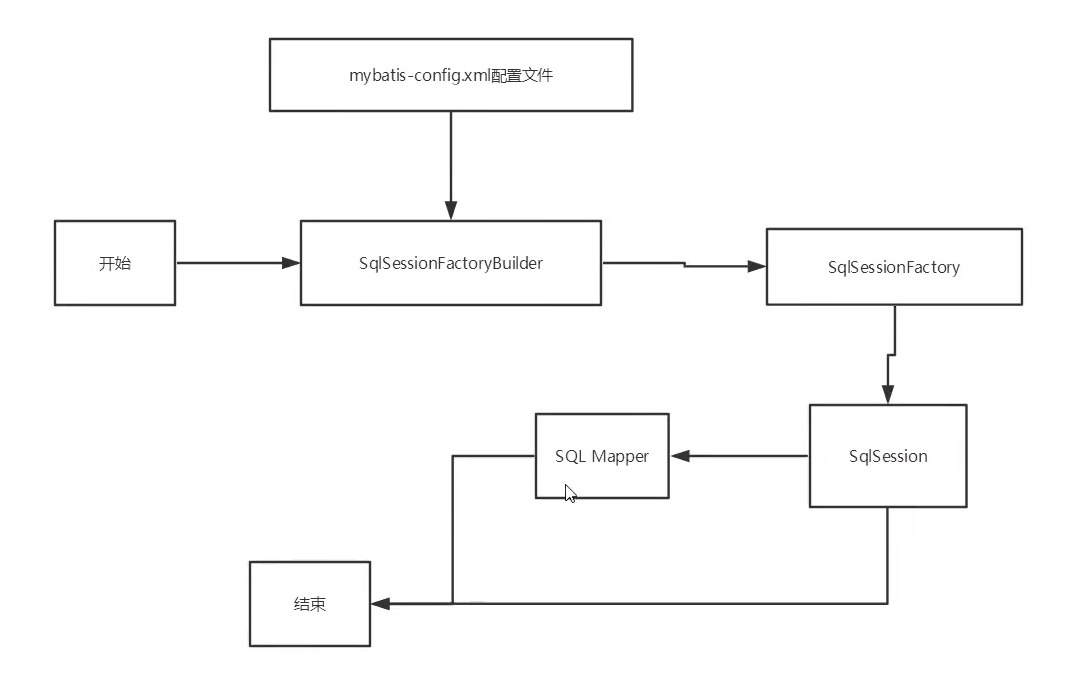
生命周期,和作用域,是至关重要的,因为错误的使用会导致非常严重的并发问题。
SqlSessionFactoryBuilder
- 一旦创建了SqlSessionFactory,就不再需要他了
- 局部变量
SqlSessionFactory
- 说白了就是可以想象为:数据库连接池
- SqlSessionFactory一旦被创建就应该在应用运行的期间一直存在,没有任何理由丢弃它或重新创建另一个实例。
- 因此SqlSessionFactory的最佳作用域是应用作用域。
- 最简单的就是使用单例模式或者静态单例模式
SqlSession
- 连接到连接池的一个请求!
- 要关闭
- SqlSession 的实例不是线程安全的,因此是不能被共享的,所以它的最佳的作用域是请求或方法作用域。
- 用完之后需要赶紧关闭,否则资源被占用。
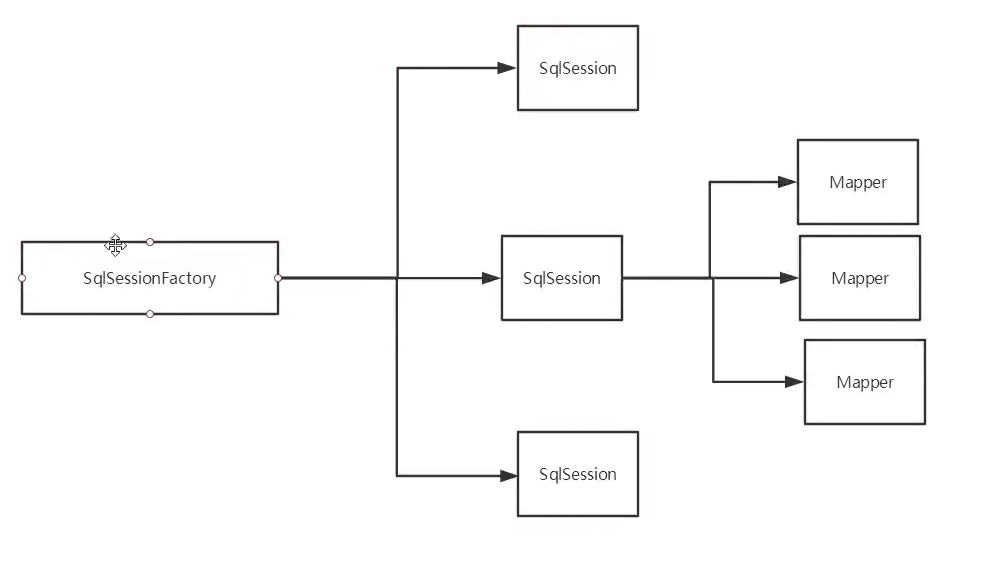
这里的每个Mapper,就代表一个具体的业务!
5、 解决属性名和字段名不一致的问题
数据库中的字段
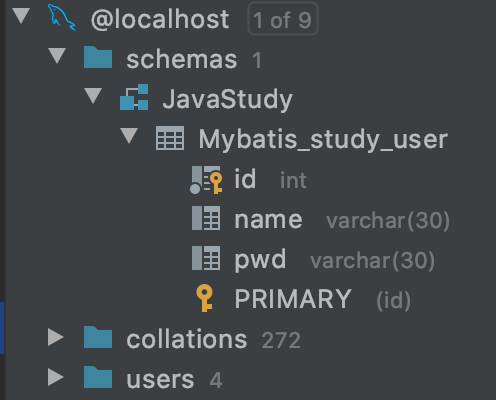
新建一个项目,拷贝之前的,测试实体类字段不一致的情况
public class User {
private int id;
private String name;
private String password;//属性名和字段名不一致
...
}测试
@Test
public void getUserById(){
SqlSession sqlSession = MybatisUtils.getSqlSession();
UserMapper mapper = sqlSession.getMapper(UserMapper.class);
User user = mapper.getUserById(1);
System.out.println(user);
}结果:
User{id=1, name='张三', password='null'}解决方法一:取别名
<select id="getUserById" parameterType="int" resultType="User">
select id,name,pwd as password from JavaStudy.Mybatis_study_user where id = #{id}
</select>结果:
User{id=1, name='张三', password='123456'}解决方法二:结果集映射
<!--resultMap的id对应select的resultMap的值-->
<resultMap id="UserMap" type="User">
<!--结果集映射-->
<!--column对应数据库中的字段,property对应实体类中的属性-->
<result column="id" property="id"/>
<result column="name" property="name"/>
<result column="pwd" property="password"/><!--pwd对应password-->
</resultMap>
<select id="getUserById" parameterType="int" resultMap="UserMap">
select * from JavaStudy.Mybatis_study_user where id = #{id}
</select>结果:
User{id=1, name='张三', password='123456'}- ResultMap元素是MyBatis中最重要最强大的元素
- ResultMap的设计思想是,对于简单的语句根本不需要配置显式的结果映射,而对于复杂一点都语句只需要描述它们的关系就行了。
- ResultMap最优秀的地方在于,虽然你已经对他相当了解了,但是根本不需要显式的用到他们。
- 如果总是这么简单就好了。
6、 日志
6.1、 日志工厂
如果一个数据库操作,出现了异常,我们需要排错,日志就是最好的助手
曾经:sout,debug
现在:日志工厂!

- SLF4J
- Apache Commons Logging
- Log4j 2
- Log4j 【掌握】
- JDK logging
- STDOUT_LOGGING 【掌握】
- NO_LOGGING
在MyBatis中具体使用哪一个日志实现,在设置中设定。
<settings>
<setting name="logImpl" value="STDOUT_LOGGING"/>
</settings>日志输出

6.2、 LOG4J
什么是Log4j?
- Log4j是Apache的一个开源项目,通过使用Log4j,我们可以控制日志信息输送的目的地是控制台、文件、GUI组件
- 我们也可以控制每一条日志的输出格式
- 通过定义每一条日志信息的级别,我们能够更加细致地控制日志的生成过程
- 通过一个配置文件来灵活地进行配置,而不需要修改应用的代码
2.1 导入依赖
<!-- https://mvnrepository.com/artifact/log4j/log4j -->
<dependency>
<groupId>log4j</groupId>
<artifactId>log4j</artifactId>
<version>1.2.17</version>
</dependency>2.2 配置文件log4j.properties
### 将等级设置为DEBG的日志输出到console和file这两个目的地,console和file的定义在下面代码
log4j.rootLogger = DEBUG,console,file
### 输出信息到控制抬 ###
log4j.appender.console = org.apache.log4j.ConsoleAppender
log4j.appender.console.Target = System.out
log4j.appender.console.Threshold = DEBUG
log4j.appender.console.layout = org.apache.log4j.PatternLayout
log4j.appender.console.layout.ConversionPattern = [%-5p] %d{yyyy-MM-dd HH:mm:ss,SSS} method:%l%n%m%n
### 输出DEBUG 级别以上的日志到logs/error.log ###
log4j.appender.file = org.apache.log4j.DailyRollingFileAppender
log4j.appender.file.File = logs/log.log
log4j.appender.file.MaxFileSize = 10mb
log4j.appender.file.Threshold = DEBUG
log4j.appender.file.layout = org.apache.log4j.PatternLayout
log4j.appender.file.layout.ConversionPattern = %-d{yyyy-MM-dd HH:mm:ss} [ %t:%r ] - [ %p ] %m%n
### 输出ERROR 级别以上的日志到=logs/error.log ###
log4j.appender.E = org.apache.log4j.DailyRollingFileAppender
log4j.appender.E.File =logs/error.log
log4j.appender.E.Append = true
log4j.appender.E.Threshold = ERROR
log4j.appender.E.layout = org.apache.log4j.PatternLayout
log4j.appender.E.layout.ConversionPattern = %-d{yyyy-MM-dd HH:mm:ss} [ %t:%r ] - [ %p ] %m%n
### 日志输出级别
log4j.logger.org.mybatis=DEBUG
log4j.logger.java.sql=DEBUG
log4j.logger.java.sql.Statement=DEBUG
log4j.logger.java.sql.ResultSet=DEBUG
log4j.logger.java.sql.PreparedStatement=DEBUG2.3 配置log4j为日志的实现
2.4 log4j的实现
<settings>
<setting name="logImpl" value="LOG4J"/>
</settings>运行后日志
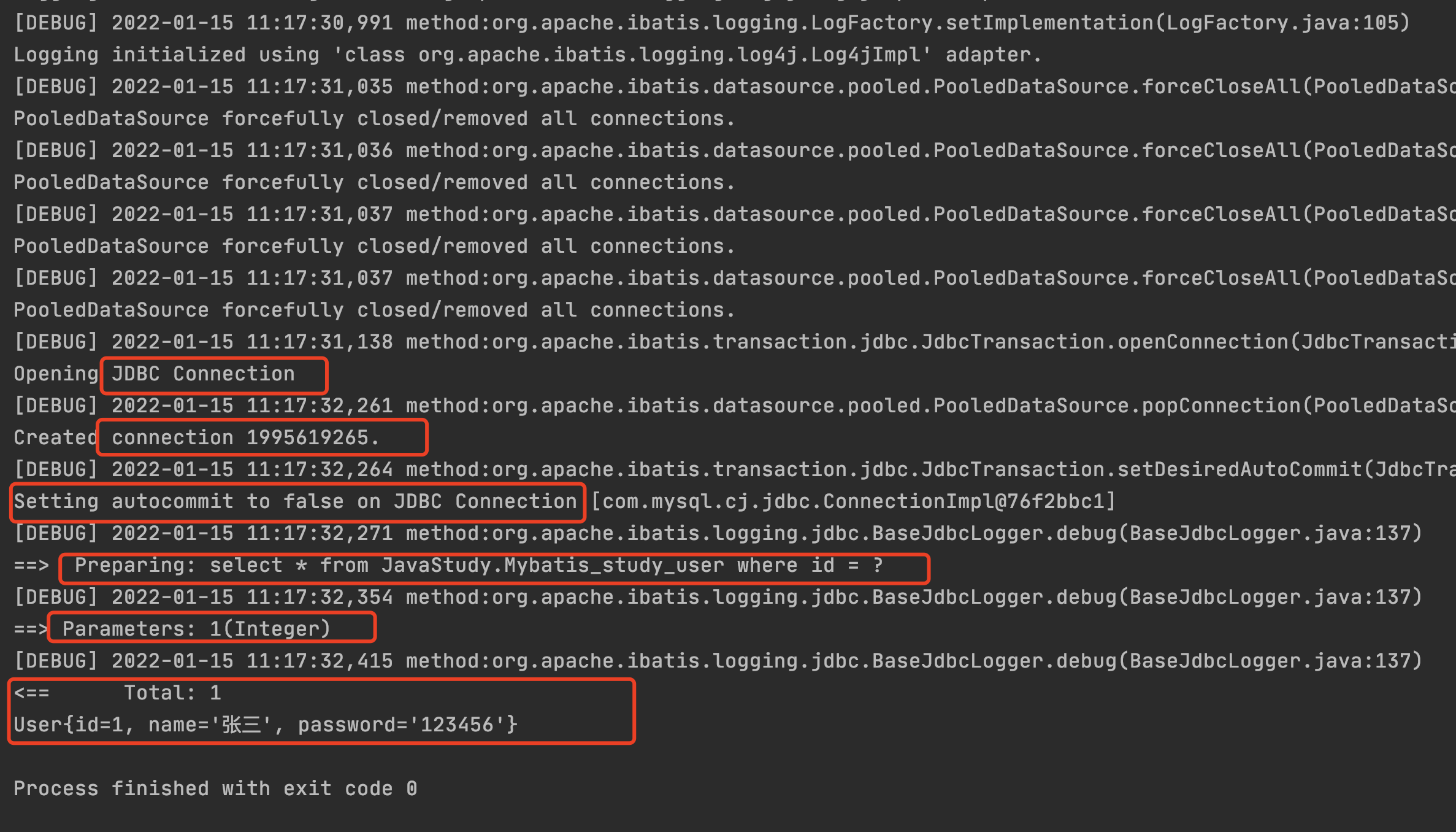
2.5 简单使用
- 在要使用Log4j的类中,导入包
import org.apache.log4j.Logger;- 日志对象,参数为当前类的class
static Logger logger = Logger.getLogger(UserDaoTest.class);- 日志级别(常用的三个)
logger.info("info:进入了testLog4j");
logger.debug("debug:进入了testLog4j");
logger.error("error:进入了testLog4j");- 日志打印
2021-10-16 15:08:41 [ main:0 ] - [ INFO ] info:进入了testLog4j
2021-10-16 15:08:41 [ main:2 ] - [ DEBUG ] debug:进入了testLog4j
2021-10-16 15:08:41 [ main:2 ] - [ ERROR ] error:进入了testLog4j7、 分页
思考:为什么要分页?
- 减少数据的处理量
7.1、使用limit分页
select * from user limit startIndex,pageSize;
##显示2条数据从0
select * from user limit 0,2;
##显示前两个数据
select * from user limit 2;使用MyBatis实现分页
- 接口
//查询分页
List<User> getUserByLimit(Map<String,Integer> map);- Mapper.xml
<select id="getUserByLimit" resultMap="UserMap" parameterType="map">
select * from mybatis.user limit #{startIndex},#{pageSize};
</select>- 测试
@Test
public void getUserByLimit(){
SqlSession sqlSession = MybatisUtils.getSqlSession();
UserMapper mapper = sqlSession.getMapper(UserMapper.class);
HashMap<String, Integer> map = new HashMap<String, Integer>();
map.put("startIndex", 0);
map.put("pageSize", 2);
List<User> userList = mapper.getUserByLimit(map);
for (User user : userList) {
System.out.println(user.toString());
}
sqlSession.close();
}7.2、 RowBounds分页
不建议使用,了解为主,这个方法是基于java面向对象实现,不再用sql实现
不再使用sql实现分页
- 接口
//分页查询2
List<User> getUserByRowBounds();- mapper.xml
<select id="getUserByRowBounds" parameterType="map" resultMap="UserMap">
select * from JavaStudy.Mybatis_study_user
</select>- 测试
@Test
public void getUserByRowBounds(){
SqlSession sqlSession = MybatisUtils.getSqlSession();
RowBounds rowBounds = new RowBounds(0, 2);
List<User> userList = sqlSession.selectList("com.gong.dao.UserMapper.getUserByRowBounds", null, rowBounds);
for (User user : userList) {
System.out.println(user.toString());
}
sqlSession.close();
}7.3、 分页插件
文档地址:https://pagehelper.github.io/

了解即可
8、 使用注解开发
8.1、 面向接口编程
- 大家之前都学过面向对象编程,也学习过接口,但在真正的项目开发中,很多时候我们会选择面向接口编程
- 根本原因:解耦,可拓展,提高复用,分层开发中,上层不用管具体的实现,大家都遵守共同点标准,使得开发变得容易,规范性更好
- 在一个面向对象的系统中,系统的各种功能是由许许多多的不同对象协作完成的,在这种情况下,各个对象的内部是如何实现自己的,对系统设计人员来讲就不那么重要了;
- 而各个对象之间的协作关系则成为系统设计的关键,小到不同类之间的通信,大到各模块之间的交互,在系统设计之初都是要着重考虑的,这也是系统设计的主要工作内容。面向接口编程就是指按照这种思想来编程。
关于接口的理解
- 接口从更深层次的理解,应是定义(规范,约束)与实现(名实分离的原则)的分离。
- 接口的本身反映了系统设计人员对系统的抽象理解。
- 接口应有两类:
- 第一类是对一个个体的抽象,它可对应为一个抽象体(abstract class)
- 第二类是对一个个体某一方面的抽象,即形成一个抽象面(interface)
- 一个个体有可能有多个抽象面,抽象体与抽象面是有区别的。
三个面向区别
- 面向对象是指,我们考虑问题时,以对象为单位,考虑它的属性及方法。
- 面向过程是指,我们考虑问题时,以一个具体的流程(事务过程)为单位,考虑它的实现。
- 接口设计与非接口设计是针对复用技术而言的,与面向对象(过程)不是一个问题,更多的体现就是对系统整体的架构。
8.2、 使用注解开发
Mybatis还是推荐通过xml配置来执行,对于简单的sql来说是比较简洁了,但是对于复杂的就不太好了
- 注解在接口上实现
package com.gong.dao;
import com.gong.pojo.User;
import org.apache.ibatis.annotations.Select;
import java.util.List;
public interface UserMapper {
//查用户
@Select("select * from Mybatis_study_user")
List<User> getUser();
}- 需要在核心配置文件中绑定接口
<mappers>
<mapper class="com.gong.dao.UserMapper"/>
</mappers>- 测试
@Test
public void getUser(){
SqlSession sqlSession = MybatisUtils.getSqlSession();
UserMapper mapper = sqlSession.getMapper(UserMapper.class);
List<User> userList = mapper.getUser();
for (User user : userList) {
System.out.println(user);
}
sqlSession.close();
}本质:反射机制实现
底层:动态代理
Mybatis详细执行流程
8.3 CRUD
- 我们可以在工具类创建到时候实现自动提交事务!
//参数设置为true,开启自动提交事务
public static SqlSession getSqlSession() {
return sqlSessionFactory.openSession(true);
}- 编写接口,增加注解
package com.gong.dao;
import com.gong.pojo.User;
import org.apache.ibatis.annotations.*;
import java.util.List;
public interface UserMapper {
//查用户
@Select("select * from Mybatis_study_user")
List<User> getUser();
//根据id查用户(根据Param)
@Select("select * from Mybatis_study_user where id = #{uid}")
User getUserById(@Param("uid") int id);
//增加用户
@Insert("insert into Mybatis_study_user(id,name,pwd) values(#{id},#{name},#{password})")
int addUser(User user);
//修改用户
@Update("update Mybatis_study_user set name = #{name},pwd = #{password} where id = #{id}")
int updateUser(User user);
//删除用户
@Delete("delete from Mybatis_study_user where id = #{uid}")
int deleteUser(@Param("uid") int id);
}
- 测试
【注意:我们必须把接口绑定注册到核心配置文件】
package com.gong.dao;
import com.gong.pojo.User;
import com.gong.utils.MybatisUtils;
import org.apache.ibatis.session.SqlSession;
import org.junit.Test;
import java.util.List;
public class UserMapperTest {
@Test
public void getUser(){
SqlSession sqlSession = MybatisUtils.getSqlSession();
UserMapper mapper = sqlSession.getMapper(UserMapper.class);
List<User> userList = mapper.getUser();
for (User user : userList) {
System.out.println(user);
}
sqlSession.close();
}
@Test
public void getUserById(){
SqlSession sqlSession = MybatisUtils.getSqlSession();
UserMapper mapper = sqlSession.getMapper(UserMapper.class);
User userById = mapper.getUserById(1);
System.out.println(userById);
sqlSession.close();
}
@Test
public void addUser(){
SqlSession sqlSession = MybatisUtils.getSqlSession();
UserMapper mapper = sqlSession.getMapper(UserMapper.class);
mapper.addUser(new User(4,"何小鹏","123321"));
sqlSession.commit();
sqlSession.close();
}
@Test
public void updateUser(){
SqlSession sqlSession = MybatisUtils.getSqlSession();
UserMapper mapper = sqlSession.getMapper(UserMapper.class);
mapper.updateUser(new User(4,"何大鹏","123456"));
sqlSession.commit();
sqlSession.close();
}
@Test
public void deleteUser(){
SqlSession sqlSession = MybatisUtils.getSqlSession();
UserMapper mapper = sqlSession.getMapper(UserMapper.class);
mapper.deleteUser(4);
sqlSession.commit();
sqlSession.close();
}
}
关于@Param()注解
- 基本类型的参数或者String类型,需要加上_
- 引用类型不需要加
- 如果只有一个基本类型的话,可以忽略,但是建议都加上。
- 我们在SQL中引用的就是我们这里的@Param()中设定的属性名!
#{}和${}的区别
$是直接进行拼接,会引发sql注入,不安全,#不会(会避免一些吧)
9、Lombok
官网地址:https://projectlombok.org/
Lombok是一个java库,可以自动插入编辑器和构建工具,提高java的性能。
永远不用再编写另一个getter或equals方法,使用一个注释,您的类就有了一个功能齐全的生成器,自动化了日志变量,等等。但是降低了代码的可读性
9.1 Lombok类中注解详解
-
@Data:注解包含包含getter、setter、NoArgsConstructor注解@Value注解和@Data类似,区别在于它会把所有成员变量默认定义为private final修饰,并且不会生成set方法
-
@getter:注解会生成对应的getter方法 -
@setter:注解会生成对应的setter方法 -
@NoArgsConstructor:注解会生成对应的无参构造方法 -
@AllArgsConstructor:注解会生成对应的有参构造方法@RequiredArgsConstructor:生成private构造方法,使用staticName选项生成指定名称的static方法。
-
@ToString:注解会自动重写对应的toStirng方法-
@ToString(exclude={"column1","column2"}):排除多个column列所对应的元素 -
@ToString(of={"column1","column2"}):只生成包含多个column列所对应的元素
-
-
@EqualsAndHashCode:注解会自动重写对应的equals方法和hashCode方法 -
@Slf4j:在需要打印日志的类中使用,项目中使用slf4j日志框架 -
@Log4j:在需要打印日志的类中使用,项目中使用log4j日志框架 -
@NonNull:注解快速判断是否为空,为空抛出java.lang.NullPointerException -
@Synchronized:注解自动添加到同步机制,生成的代码并不是直接锁方法,而是锁代码块, 作用范围是方法上 -
@Cleanup:注解用于确保已分配的资源被释放(IO的连接关闭) -
@Accessors(chain = true):链式风格,在调用set方法时,返回这个类的实例对
9.2使用步骤
- 在IDEA中安装Lombok插件!(idea设置->pluging中搜索)
- 在项目中引入依赖
<!-- https://mvnrepository.com/artifact/org.projectlombok/lombok -->
<dependency>
<groupId>org.projectlombok</groupId>
<artifactId>lombok</artifactId>
<version>1.18.12</version>
</dependency>- 在实体类上加注解
- 常用说明
@Data:无参构造,get,set,toString,equals,hashcode方法
@NoArgsConstructor:无参构造
@AllArgsConstructor:有参构造10、 多对一处理
多对一(关联) 和 一对多(集合)
学生与老师的关系
SQL
CREATE TABLE `Mybatis_study_teacher` (
`id` INT(10) NOT NULL,
`name` VARCHAR(30) DEFAULT NULL,
PRIMARY KEY (`id`)
) ENGINE=INNODB DEFAULT CHARSET=utf8;
INSERT INTO Mybatis_study_teacher(`id`, `name`) VALUES (1,'秦老师');
INSERT INTO Mybatis_study_teacher(`id`, `name`) VALUES (2,'龚老师');
CREATE TABLE `Mybatis_study_student` (
`id` INT(10) NOT NULL,
`name` VARCHAR(30) DEFAULT NULL,
`tid` INT(10) DEFAULT NULL,
PRIMARY KEY (`id`),
KEY `fktid` (`tid`),
CONSTRAINT `fktid` FOREIGN KEY (`tid`) REFERENCES `Mybatis_study_teacher` (`id`)
) ENGINE=INNODB DEFAULT CHARSET=utf8;
INSERT INTO `Mybatis_study_student` (`id`, `name`, `tid`) VALUES (1, '小明', 1);
INSERT INTO `Mybatis_study_student` (`id`, `name`, `tid`) VALUES (2, '小红', 1);
INSERT INTO `Mybatis_study_student` (`id`, `name`, `tid`) VALUES (3, '小张', 1);
INSERT INTO `Mybatis_study_student` (`id`, `name`, `tid`) VALUES (4, '小李', 1);
INSERT INTO `Mybatis_study_student` (`id`, `name`, `tid`) VALUES (5, '小王', 1);
INSERT INTO `Mybatis_study_student` (`id`, `name`, `tid`) VALUES (6, '小刘', 2);测试环境搭建
- 导入lombok
- 新建实体类Teacher,Student
- 建立Mapper接口
- 建立Mapper.xml文件
- 在核心配置文件中绑定注册我们的Mapper接口或者文件!【方式很多】
- 测试查询是否能够成功!
实体类
Student
package com.gong.pojo;
import lombok.Data;
@Data
public class Student {
private int id;
private String name;
//一个学生对应一个老师
private Teacher teacher;
}
Teacher
package com.gong.pojo;
import lombok.Data;
@Data
public class Teacher {
private int id;
private String name;
}按照查询嵌套处理
<?xml version="1.0" encoding="UTF-8" ?>
<!DOCTYPE mapper
PUBLIC "-//mybatis.org//DTD Config 3.0//EN"
"http://mybatis.org/dtd/mybatis-3-mapper.dtd">
<mapper namespace="com.gong.dao.StudentMapper">
<!--
多对一查询 方法一:
1.查询所有学生信息
2.根据查询出来学生的tid,寻找对应的老师(双表查询)
-->
<select id="getStudent" resultMap="StudentTeacher">
select * from Mybatis_study_student
</select>
<resultMap id="StudentTeacher" type="student">
<id property="id" column="id"/><!--id和result一样,主键通常用id-->
<result property="name" column="name"/>
<!--复杂查询 select参数类似于子查询 association:对象 collection:集合-->
<association property="teacher" column="tid" javaType="Teacher" select="getTeacher"/>
</resultMap>
<!--子查询-->
<select id="getTeacher" resultType="Teacher">
select * from Mybatis_study_teacher where id = #{tid}
</select>
</mapper>按照结果嵌套查询
<?xml version="1.0" encoding="UTF-8" ?>
<!DOCTYPE mapper
PUBLIC "-//mybatis.org//DTD Config 3.0//EN"
"http://mybatis.org/dtd/mybatis-3-mapper.dtd">
<mapper namespace="com.gong.dao.StudentMapper">
<!--
多对一查询 方法二:
1.查询所有学生信息
2.按照结果集嵌套处理
-->
<select id="getStudent2" resultMap="StudentTeacher2">
select s.id sid,s.name sname, t.name tname,t.id tid
from Mybatis_study_student s, Mybatis_study_teacher t
where s.tid = t.id
</select>
<resultMap id="StudentTeacher2" type="Student">
<id property="id" column="sid"/>
<result property="name" column="sname"/>
<association property="teacher" javaType="Teacher">
<result property="name" column="tname"/>
<result property="id" column="tid"/>
</association>
</resultMap>
</mapper>回顾Mysql多对一查询方式:
- 子查询
- 联表查询
package com.gong.dao;
import com.gong.pojo.Student;
import com.gong.pojo.Teacher;
import com.gong.utils.MybatisUtils;
import org.apache.ibatis.session.SqlSession;
import org.junit.Test;
import java.util.List;
public class TeacherMapperTest {
@Test
public void getTeacherbyId(){
SqlSession sqlSession = MybatisUtils.getSqlSession();
TeacherMapper mapper = sqlSession.getMapper(TeacherMapper.class);
Teacher teacherById = mapper.getTeacherById(1);
System.out.println(teacherById);
sqlSession.close();
}
@Test
public void getStudent(){
SqlSession sqlSession = MybatisUtils.getSqlSession();
StudentMapper mapper = sqlSession.getMapper(StudentMapper.class);
List<Student> studentList = mapper.getStudent();
for (Student student : studentList) {
System.out.println(student);
}
sqlSession.close();
}
@Test
public void getStudent2(){
SqlSession sqlSession = MybatisUtils.getSqlSession();
StudentMapper mapper = sqlSession.getMapper(StudentMapper.class);
List<Student> studentList = mapper.getStudent2();
for (Student student : studentList) {
System.out.println(student);
}
sqlSession.close();
}
}
11、一对多处理
比如:一个老师有多个学生!
环境搭建
- 导入lombok
- 新建实体类Teacher,Student
- 建立Mapper接口
- 建立Mapper.xml文件
- 在核心配置文件中绑定注册我们的Mapper接口或者文件!【方式很多】
- 测试查询是否能够成功
实体类和上面不一样
Student
package com.gong.pojo;
import lombok.Data;
@Data
public class Student {
private int id;
private String name;
//一个学生对应一个老师
private int tid;
}Teacher
package com.gong.pojo;
import lombok.Data;
import java.util.List;
@Data
public class Teacher {
private int id;
private String name;
//一个老师有多个学生
private List<Student> students;
}按照查询嵌套查询
<?xml version="1.0" encoding="UTF-8" ?>
<!DOCTYPE mapper
PUBLIC "-//mybatis.org//DTD Config 3.0//EN"
"http://mybatis.org/dtd/mybatis-3-mapper.dtd">
<mapper namespace="com.gong.dao.TeacherMapper">
<!--方法二:-->
<select id="getTeacherById2" resultMap="TeacherStudent2">
select * from Mybatis_study_teacher where id = #{tid}
</select>
<resultMap id="TeacherStudent2" type="Teacher">
<result property="id" column="id"/>
<result property="name" column="name"/>
<!--ofType是列表中元素的类型-->
<collection property="students" javaType="ArrayList" ofType="Student" select="getStudents" column="id" />
</resultMap>
<select id="getStudents" resultType="Student">
select * from Mybatis_study_student where tid = #{tid}
</select>
</mapper>按照结果集嵌套查询
<?xml version="1.0" encoding="UTF-8" ?>
<!DOCTYPE mapper
PUBLIC "-//mybatis.org//DTD Config 3.0//EN"
"http://mybatis.org/dtd/mybatis-3-mapper.dtd">
<mapper namespace="com.gong.dao.TeacherMapper">
<!--方法一:按照结果集嵌套-->
<select id="getTeacherById" resultMap="TeacherStudent">
select s.id sid,s.name sname,t.name tname,t.id tid
from Mybatis_study_student s , Mybatis_study_teacher t
where s.tid = t.id and t.id = #{tid}
</select>
<resultMap id="TeacherStudent" type="Teacher">
<result property="id" column="tid"/>
<result property="name" column="tname"/>
<!--复杂属性需要单独处理
javaType = " " 指定属性的类型
集合中的泛型信息,我们使用ofType提取
-->
<collection property="students" ofType="Student">
<result property="id" column="sid"/>
<result property="name" column="sname"/>
<result property="tid" column="tid"/>
</collection>
</mapper>小结
- 关联association 【多对一】
- 集合colection 【一对多】
- javaType & ofType
- JavaType 用来指定实体类中属性的类型
- ofType 用来指定映射到List或者集合中的pojo类型,泛型中的约束类型!
注意点:
- 保证SQL的可读性,尽量保证通俗易懂
- 注意一对多和多对一中,属性名和字段的问题!
- 如果问题不好排查错误,可以使用日志,建议使用Log4j
- 要避免慢SQL
面试高频
- Mysql引擎
- 索引
- 索引优化
- InnoDB底层原理
12、 动态SQL
什么是动态SQL:动态SQL就是指根据不同的条件生成不同的SQL语句
利用动态SQL这一特性可以彻底摆脱代码拼接SQL的痛苦
动态SQL元素和JSTL 或基于类似XML的文本处理器相似。在Mybatis 之前的版本中,有很多元素需要花时间了解。Mybatis3 大大精简了元素种类,现在只需学习原来一半的元素便可。Mybtis 采用功能强大的基于OGNL的表达式来淘汰其它大部分元素。
- if
- choose(when, otherwise)
- trim(where, set)
- foreach
环境搭建
CREATE TABLE `blog`(
`id` VARCHAR(50) NOT NULL COMMENT '博客id' PRIMARY KEY,
`title` VARCHAR(100) NOT NULL COMMENT '博客标题',
`author` VARCHAR(30) NOT NULL COMMENT '作者',
`create_time` DATETIME NOT NULL COMMENT '创建时间',
`views` INT(30) NOT NULL COMMENT '浏览量'
) DEFAULT CHARSET=utf8创建一个基础工程
- 导包
- 编写配置文件
- 编写实体类
@Data
@AllArgsConstructor //有参构造器
@NoArgsConstructor //无惨
public class Blog {
private String id;
private String title;
private String author;
private Date createTime; //设置驼峰命名映射为true
private int views;
}- 编写实体类对应Mapper接口和Mapper.xml文件
IF
mapper.xml中
<select id="queryBLog" parameterType="map" resultType="blog">
select * from Mybatis_study_blog where 1=1
<if test="author != null">
and author = #{author}
</if>
<if test="title != null">
and title = #{title}
</if>
</select>
<!--更改后-->
<select id="queryBLog" parameterType="map" resultType="blog">
select * from Mybatis_study_blog
<where>
<if test="author != null">
author = #{author}
</if>
<if test="title != null">
and title = #{title}
</if>
</where>
</select>上面这个代码加了where 1=1是不规范的 我们可以采用where标签
where标签的作用:自动添加where并且会自动判断去掉and或者or
choose(when, otherwise)
choose类似于java的switch语句一次选择一个满足的条件 ,满足则退出
<select id="queryBlogChoose" resultType="blog" parameterType="map">
select * from Mybatis_study_blog
<where>
<choose>
<when test="author != null">
author = #{author}
</when>
<when test="title != null">
title = #{title}
</when>
<otherwise>
views = #{views}
</otherwise>
</choose>
</where>
</select>trim(where,set)
-
trim可以定制where和set
-
where在if更新中用到过,下面主要是set 用于更新表
<update id="updateBlog" parameterType="map">
update Mybatis_study_blog
<set>
<if test="author!=null">
author=#{author},
</if>
<if test="title!=null">
title=#{title},
</if>
<if test="views!=null">
views=#{views}
</if>
<!-- <where>-->
<!-- <if test="id!=null">-->
<!-- id=#{id}-->
<!-- </if>-->
<!-- </where>-->
<!-- 感觉写在set外更好 因为where不存在则会更新所有表-->
</set>
where id = #{id}
</update>所谓的动态SQL,本质还是SQL语句,只是我们可以在SQL层面,去执行一个逻辑代码
if,where,set,choose,when
SQL片段
有时候,我们可能会将一些功能的部分抽取出来,方便复用
- 使用SQL标签抽取公共的部分
<sql id="if-author-title">
<if test="title!=null">
and title=#{title}
</if>
<if test="author!=null">
and author=#{author}
</if>
</sql>- 在需要使用的地方使用
include标签引用即可
<select id="queryBlog" parameterType="map" resultType="blog">
select * from blog
<where>
<include refid="if-author-title"></include>
</where>
</select>注意事项:
- 最好基于单表来定义SQL片段!
- 不要存在where标签
Foreach
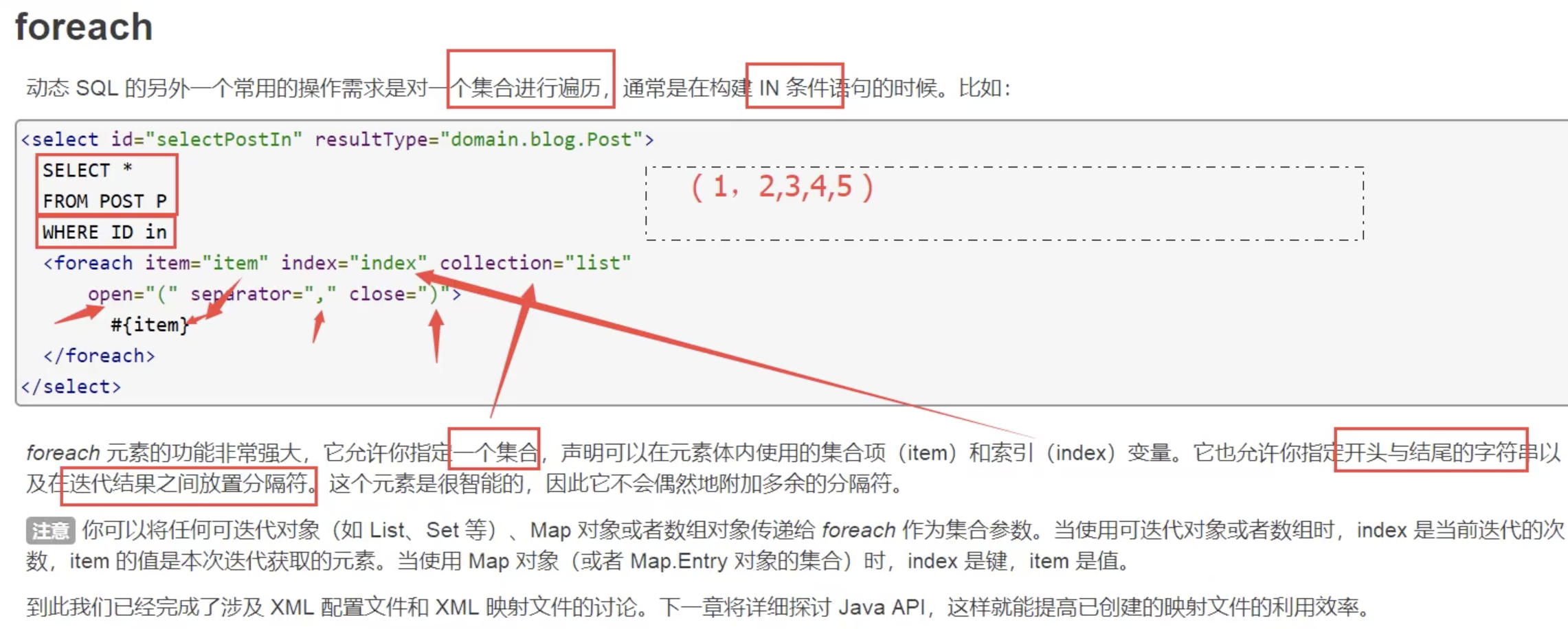
<!--select * from JavaStudy.Mybatis_study_blog
where id =1 or id = 2 or id = 3;
-->
<select id="queryBlogForeach" parameterType="map" resultType="Blog">
select * from JavaStudy.Mybatis_study_blog
<where>
<foreach collection="ids" item="id" open=" " separator="or" close=" ">
id = #{id}
</foreach>
</where>
</select>测试:
@Test
public void queryBlogForeach(){
SqlSession sqlSession = MybatisUtils.getSqlSession();
BlogMapper mapper = sqlSession.getMapper(BlogMapper.class);
HashMap map = new HashMap();
ArrayList<Integer> ids = new ArrayList<Integer>();
ids.add(1);
ids.add(2);
ids.add(3);
map.put("ids",ids);
List<Blog> blogs = mapper.queryBlogForeach(map);
for (Blog blog : blogs) {
System.out.println(blog);
}
sqlSession.close();
}输出
<== Row: 1, Java, 小鹏, 2022-01-18 20:27:43, 1111
<== Row: 2, 微服务, 狂神说, 2022-01-18 20:35:16, 9999
<== Row: 3, Spring, 小鹏, 2022-01-18 20:35:16, 9999动态SQL就是在拼接SQL语句,我们只要保证SQL的正确性,按照SQL的格式去排列组合就可以了
建议:
- 先在MySql中写出完整的SQL再对应的钱修改成我们需要的动态SQL实现通用即可。
13、 缓存
13.1、 简介
我们应该知道连接数据库是十分浪费资源的,一次查询的结果,我们可以将他暂存到一个可以直接取到的地方,也就是内存中,存在内存中的查询结果我们就将它称为缓存,当我们再次查询相同数据的时候,直接走缓存,就不用了走数据库了
- 什么是缓存【Cache】?
- 在内存中的临时数据。
- 将用户经常查询的数据放在缓存(内存)中,用户去查询数据就不用从磁盘上(关系型数据库数据文件)查询,从缓存中查询,从而提高效率,解决了高并发系统的性能问题。
- 为什么使用缓存?
- 减少和数据库的交互次数,减少系统开销,提高系统效率。
- 什么样的数据能使用缓存?
- 经常查询并且不经常改变的数据。
13.2、 Mybatis缓存
-
ByBatis包含一个非常强大的查询缓存特性,它可以非常方便地定制和配置缓存。缓存可以极大的提升查询效率。
-
MyBatis系统中默认定义了两级缓存:一级缓存和二级缓存
- 默认情况下,只有一级缓存开启。(SqlSession级别的缓存,也称为本地缓存)
- 二级缓存需要手动开启和配置,他是基于namespace级别的缓存。
- 为了提高扩展性,MyBatis定义了缓存接口Cache。我们可以通过实现Cache接口来自定义二级缓存。
13.3、 一级缓存
- 一级缓存也叫本地缓存:SqlSession
- 与数据库同一次会话期间查询到的数据会放在本地缓存中。
- 以后如果需要获取相同的数据,直接从缓存中取,没必要再去查询数据库。
测试步骤:
- 开启日志!
- 测试在一个Session中查询两次相同记录
- 查看日志输出
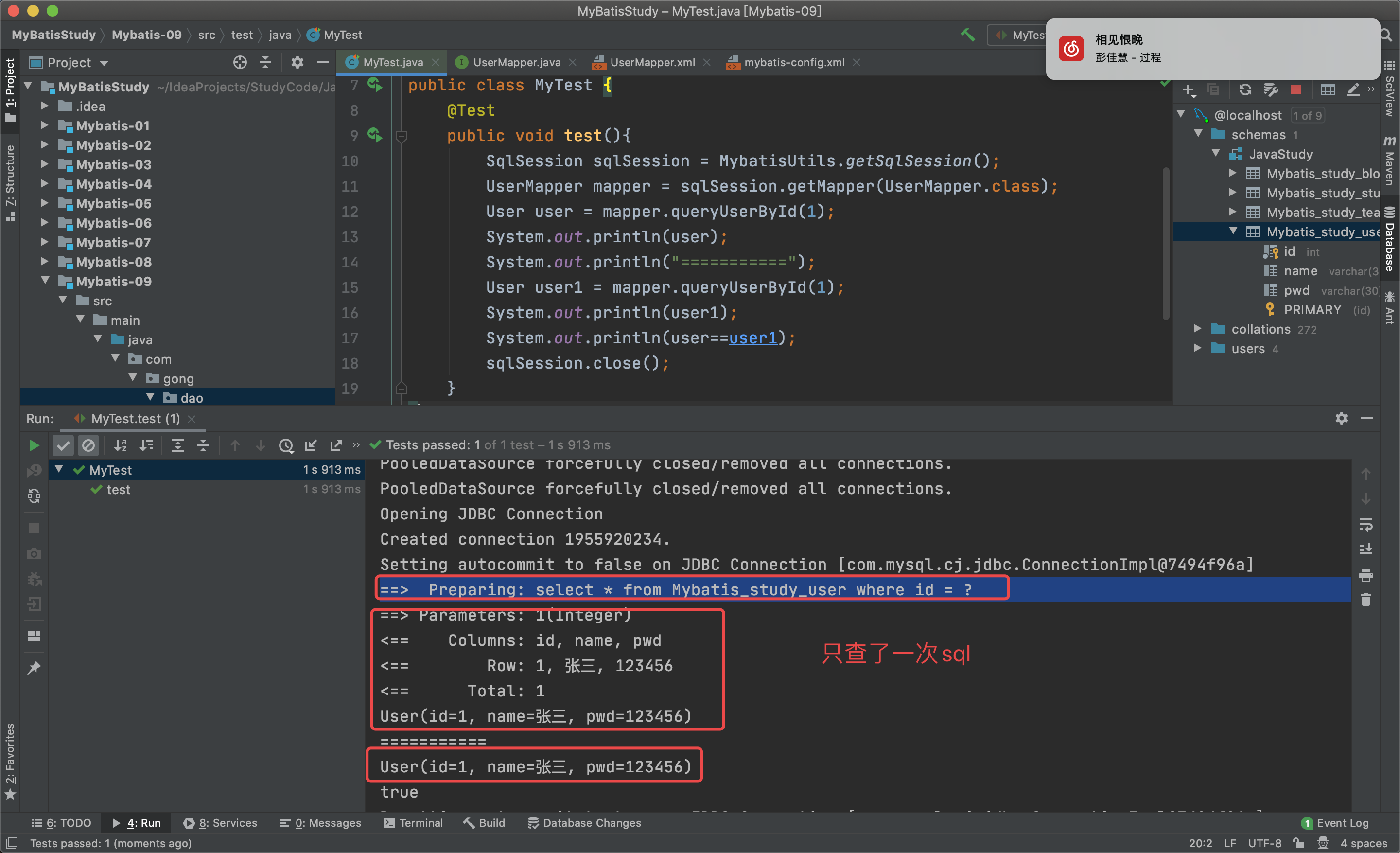
缓存失效情况:
- 查询不同的东西
- 增删改操作,可能会改变原来的数据,所以必定会刷新缓存!
- 查询不同的Mapper.xml
- 手动清楚缓存
sqlSession.clearCache
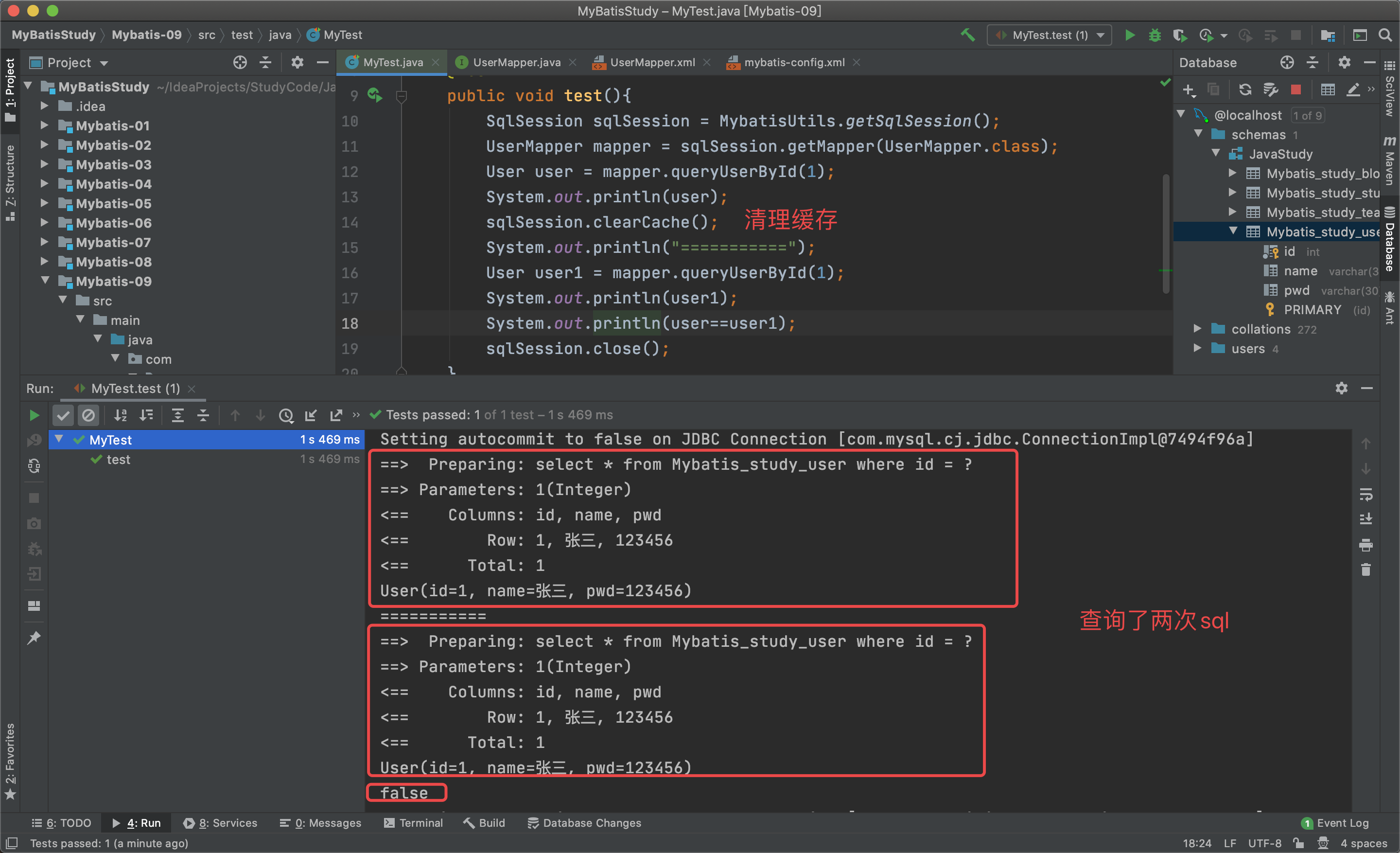
小结:
一级缓存默认是开启的,只在一次SqlSession中有效,也就是拿到连接到关闭连接这个区间段!
一级缓存相当于一个Map(存一次,之后取着方便)
13.4、 二级缓存
- 二级缓存也叫全局缓存,一级缓存作用域太低了,所以诞生了二级缓存
- 基于namespace级别的缓存,一个名称空间,对应一个二级缓存。
- 工作机制
- 一个会话查询一条数据,这个数据就会被放在当前会话的一级缓存中;
- 如果当前会话关闭了,这个会话对应的一级缓存就没了,但是我们想要的是,会话关闭了,一级缓存中的数据被保存到二级缓存中。
- 新的会话查询信息,就可以从二级缓存中获取内容。
- 不同的mapper查出的数据会放在自己对应的缓存(map)中
步骤:
1.开启全局缓存
核心配置文件中设置开启缓存
<settings>
<setting name="cacheEnabled" value="true"/>
</settings>- 在要使用二级缓存的Mapper中开启
<mapper namespace="com.gong.dao.BlogMapper">
<cache/>
</mapper> 也可以自定义参数
<mapper namespace="com.xia.dao.BlogMapper">
<!--可以直接添加<cache/>标签即可-->
<cache
eviction="FIFO"
size="512"
readOnly="true"
flushInterval="60000">
/>
</mapper>测试
- 问题:我们需要将实体类序列化!否则就会报错!
Caused by:java.io.NotSerializableException:com.gong.pojo.User小结:
- 只要开启了二级缓存,在同一个Mapper下就有效
- 所有的数据都会先放在一级缓存中
- 只有当会话提交,或者关闭的时候,才会提交到二级缓存中!
13.5、 缓存原理
查询顺序
- 先看二级缓存中有没有
- 如果没有,再看一级缓存中有没有
- 如果没有再查询数据库
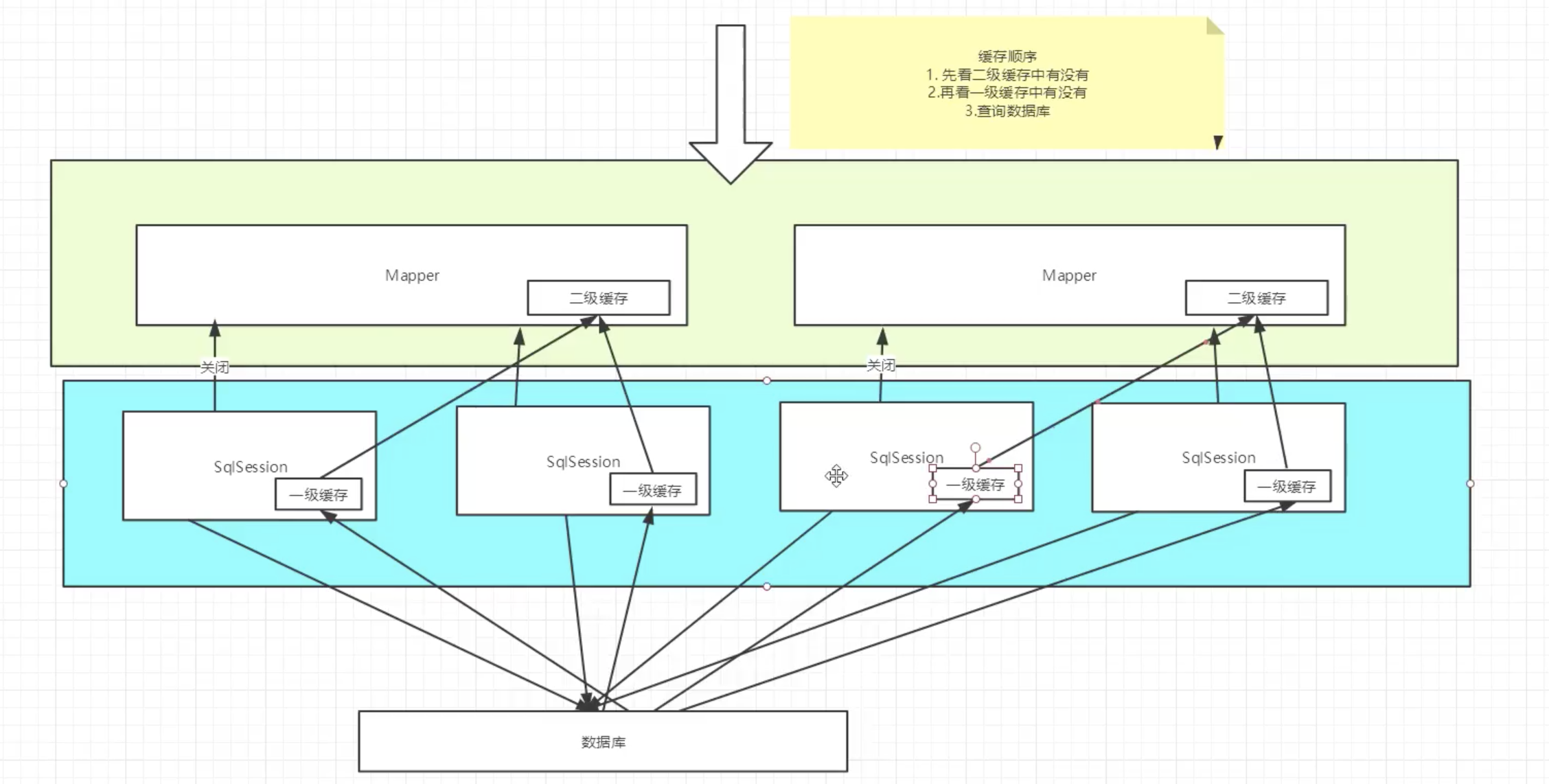
13.6、 自定义缓存-ehcache
第三方缓存实现:EhCache
Ehcache 是一种广泛使用的 java 分布式缓存,用于通用缓存。
使用步骤
- 要引入依赖的jar包。
<!-- https://mvnrepository.com/artifact/org.mybatis.caches/mybatis-ehcache -->
<dependency>
<groupId>org.mybatis.caches</groupId>
<artifactId>mybatis-ehcache</artifactId>
<version>1.1.0</version>
</dependency>- 在mapper.xml中使用对应的缓存即可
<mapper namespace="org.acme.FooMapper">
<cache type="org.mybatis.caches.ehcache.EhcacheCache"/>
</mapper>- 编写ehcache.xml文件,如果在加载时未找到/ehcache.xml资源或出现问题,则将使用默认配置。
<?xml version="1.0" encoding="UTF-8"?>
<ehcache xmlns:xsi="http://www.w3.org/2001/XMLSchema-instance"
xsi:noNamespaceSchemaLocation="http://ehcache.org/ehcache.xsd"
updateCheck="false">
<diskStore path="./tmpdir/Tmp_EhCache"/>
<defaultCache
eternal="false"
maxElementsInMemory="10000"
overflowToDisk="false"
diskPersistent="false"
timeToIdleSeconds="1800"
timeToLiveSeconds="259200"
memoryStoreEvictionPolicy="LRU"/>
<cache
name="cloud_user"
eternal="false"
maxElementsInMemory="5000"
overflowToDisk="false"
diskPersistent="false"
timeToIdleSeconds="1800"
timeToLiveSeconds="1800"
memoryStoreEvictionPolicy="LRU"/>
</ehcache>diskStore
缓存路径,ehcache分为内存和磁盘两级,此属性定义磁盘的缓存位置。参数解释如下:
- user.home – 用户主目录
- user.dir – 用户当前工作目录
- java.io.tmpdir – 默认临时文件路径
defaultCache
默认缓存策略,当ehcache找不到定义的缓存时,则使用这个缓存策略。只能定义一个。
name
缓存名称。
maxElementsInMemory
缓存最大数目
maxElementsOnDisk
硬盘最大缓存个数。
eternal
对象是否永久有效,一但设置了,timeout 将不起作用。
overflowToDisk
当系统宕机时,是否保存到磁盘。
timeToIdleSeconds
- 设置对象在失效前的允许闲置时间(单位:秒)。
- 仅当eternal=false对象不是永久有效时使用,可选属性,默认值是0,也就是可闲置时间无穷大。
timeToLiveSeconds
- 设置对象在失效前允许存活时间(单位:秒)。
- 最大时间介于创建时间和失效时间之间。
- 仅当eternal=false对象不是永久有效时使用,默认是0,也就是对象存活时间无穷大。
diskPersistent
是否缓存虚拟机重启期数据,默认值为 false。
diskSpoolBufferSizeMB
- 这个参数设置 DiskStore(磁盘缓存)的缓存区大小。默认是30MB。
- 每个Cache都应该有自己的一个缓冲区。
diskExpiryThreadIntervalSeconds
磁盘失效线程运行时间间隔,默认是120秒。
memoryStoreEvictionPolicy
- 当达到 maxElementsInMemory 限制时,Ehcache 将会根据指定的策略去清理内存。
- 默认策略是LRU(最近最少使用),可以设置为FIFO(先进先出)或是LFU(较少使用)。
- FIFO,first in first out,这个是大家最熟的,先进先出。
- LFU, Less Frequently Used,就是上面例子中使用的策略,直白一点就是讲一直以来最少被使用的。如上面所讲,缓存的元素有一个hit属性,hit值最小的将会被清出缓存。
- LRU,Least Recently Used,最近最少使用的,缓存的元素有一个时间戳,当缓存容量满了,而又需要腾出地方来缓存新的元素的时候,那么现有缓存元素中时间戳离当前时间最远的元素将被清出缓存。
clearOnFlush
内存数量最大时是否清除。
一句话描述Mybatis:用xml配置文件替代原来的接口实现,将xml在核心配置文件中注册,配置文件中可以设置很多东西